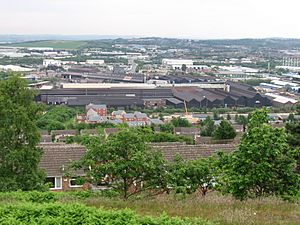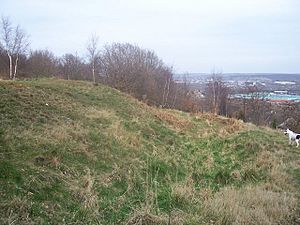Wincobank (hill fort) facts for kids
Wincobank is an ancient hill fort from the Iron Age. It is located near the area also called Wincobank in Sheffield, England. This historic site gives us clues about how people lived thousands of years ago.
Contents
Where is Wincobank Fort?

This fort sits on its own sandstone hill. This hill forms the northern side of the valley where the River Don flows. From the fort, you can see far across the valley.
What Does the Fort Look Like?
The Wincobank fort is shaped like an oval. It covers about 1 hectare, which is roughly the size of two and a half football fields!
Fort Defenses
The entire fort was protected by a large ditch. This ditch was originally between 1.5 and 2 meters deep. Outside the ditch, there was a raised bank called a counterscarp. This bank was made from the earth and rocks dug out of the ditch.
The main wall, or rampart, was also very strong. Its outer side was built with stones held together by wooden beams. Some of these wooden beams show signs of being vitrified. This means they were heated so intensely that they turned into a glassy substance. This might have happened during a big fire, perhaps from a battle in the late Iron Age.
Fort Entrances
For a long time, people thought the fort had two main entrances. These were breaks in the rampart on the north-east and south-west sides. However, experts now believe the real entrance was on the south-east side. At this spot, the rampart turns slightly inwards. Near this entrance, there is a small mound. This mound might have been the base for a watch tower.
Who Lived at Wincobank Fort?
Early historians once thought the Romans built this fort. But archaeologists now believe it was built by the Brigantes, a powerful Celtic tribe.
A Defensive Line?
Some historians think Wincobank fort was part of a defensive line. This line was built by the Brigantes around the 1st century AD. They might have used it to try and stop the Romans from moving further north into Britain. Other forts like Carl Wark and Scholes Coppice might have been part of this same defense. There's also an old earthwork called Roman Rig that runs from Wincobank fort towards Mexborough.
The Name Wincobank
The name "Wincobank" was first written down in 1442 as "Wincowe". It probably comes from two older words. "Wineca" was an Anglo-Saxon person's name. "Haugr" is an Old Norse word meaning a mound or hill. So, "Wincobank" likely means "Wineca's hill".
Wincobank in World War II
During the Second World War, Wincobank hill was used for defense. An anti-aircraft gun and a searchlight were placed next to the south-west corner of the fort. These were used to spot and shoot down enemy planes.



